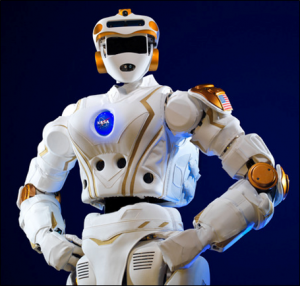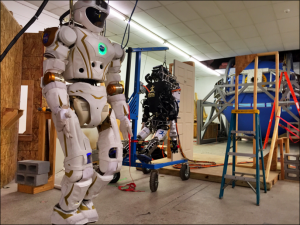A giant leap for robotkind
- October 12, 2015
- / David Tortorano
- / economy

NASA’s Valkyrie. NASA photo
PENSACOLA, Fla. -- One day in the not too distant future, a spacecraft will land on an alien planet and a team of rugged humanoid robots will leave the craft and begin building habitats for their partners, the far more fragile human beings who will eventually, inevitably follow.
The robots may be autonomous, or they may be avatars controlled by humans orbiting above. Either scenario is possible, and will mark a giant leap for robotkind.
This sci-fi vision is on its way to becoming science fact as teams gear up to create robots that will be the hard-working partners of astronauts. And one organization from the Gulf Coast that’s in the thick of it is the Florida Institute for Human and Machine Cognition in downtown Pensacola.
It’s highly likely that space-traveling robots will owe their ability to walk and climb obstacles without losing their balance to the scientists and technicians at IHMC who have proven they have the right stuff when it comes to creating locomotion algorithms for robots.
IHMC, which started as a part of the University of West Florida in 1990, has earned an international reputation for its work in human and machine interaction. Ken Ford, president and CEO of IHMC, says the organization has been working on locomotion systems for legged robots for 13 years.
Its expertise in the field is already well-known. NASA has already tapped IHMC for its expertise to help it develop walking capabilities for future space robots.
“We have a grant from the National Robotics Initiative and NASA’s Johnson Space Center that started three years ago,” said Peter Neuhaus, a senior research scientist at IHMC who, with colleague Jerry Pratt, heads up the robotic locomotion team.
One of the goals of the National Robotics Initiative, announced in 2011, was to create robots that would assist in missions in hazardous environments. The grant is aimed at co-exploration by humans and robots, with the first goal of creating avatars controlled by humans.
IHMC’s expertise was underscored during the multi-year, multi-phase DARPA Robotics Challenge, launched in 2012 in response to Japan’s Fukushima nuclear disaster. The idea was to create robots that could help go into areas too dangerous to humans. IHMC, as one of the early leaders in the competition, was provided with the Atlas robot, created by Boston Dynamics. IHMC developed the program to allow the six-foot tall robot, called “Running Man,” to perform a range of tasks necessary in responding to a disaster, from opening doors to cutting holes and climbing over an uneven debris field.
The winner of the final June 2015 competition in California was a robot created by South Korea. IHMC came in second, best of all the U.S. teams, which included others using an Atlas robot. Significantly, Running Man was able to do all tasks while keeping its balance.
“It was an extremely high profile event and certainly helped raise IHMC’s image outside the scientific engineering community,” said Ford.
Now that IHMC expertise is being used by NASA to provide some of the brain power, so to speak, for NASA’s impressive-looking Valkyrie humanoid robot that will one day help astronauts explore distant worlds.
Valkyrie, which many have pointed out has distinctly female features, did participate in the DARPA Robotics Challenge Trials, and shared last place with two other teams after scoring zero points during the 2013 challenge in South Florida. Val didn’t take part in the California competition, but two of them were on display and performed some tasks.
One Valkyrie robot, known by the mundane designation R5, spent August and much of September at IHMC so the team could work on its bipedal control algorithm. NASA’s plan is the IHMC’s expertise in locomotion will be used in all the R5 robots that will be at the center of a new competition recently launched by NASA.

Valkyrie at IHMC in August 2015 for some work. In the background is the Atlas robot that placed 2nd in the DARPA competition. IHMC photo
Called the Space Robotics Challenge, it aims to improve humanoid robots so they can go to Mars and help humans. One of the anticipated missions is to send a team of NASA’s Valkyrie robots to Mars ahead of humans so they can build habitats for astronauts.
The NASA competition is in large part building upon the DARPA Robotics Challenge. NASA recently issued a research announcement to find one or two host sites that will receive Valkyrie robots. To be eligible, a host site must have participated in the DRC and be a U.S. university. IHMC is ineligible to be a host site because of the university requirement.
In the summer of 2016, NASA plans to have the virtual part of the Space Robotics Challenge, where teams will use computers to see how well their software performs.
The top teams - how many has not been announced - then will be selected to participate further in the SRC. They will have access to the Valkyrie robot by traveling to one of the host sites to test their algorithms on the robot.
In the fall of 2017, the teams will compete in the Space Robotics Challenge finals, performing tasks useful in space exploration, like climbing into and out of a structure, down a ladder to a rocky surface, and connecting power sources.
The goal is to improve the autonomy of walking robots, so they can solve problems on their own, without the intervention of a human controller. The reason is simple. As distances increase it’s takes longer for a command to be received and executed. Autonomy eliminates that problem. But that, said Neuhaus, is a ways off.
While it’s unclear whether IHMC will participate in the NASA challenge, it is, nonetheless, a key participant. Neuhaus said IHMC’s role is to develop the walking and balance capabilities so that the teams that compete do not have to become experts in developing that part of the robot. Part of that task is developing that part of the robot’s software.
Gulf_Coast_Aerospace_Corridor.com is a website created in 2008 to highlight aerospace activities along the Interstate 10 corridor between New Orleans and Northwest Florida. It includes reference material, job postings, a daily aerospace newsfeed and weekly column. In 2011, the website teamed with several journalists to create the Gulf Coast Reporters’ League, which writes and publishes an annual book about aerospace in the region. The first book was published in June 2011. In September 2013, the League launched an eight-page quarterly aerospace newsletter, which became a bimonthly in August 2014 after the League published the fourth edition of the annual.
All the books can be found at: www.gulfcoastaerospacecorridor.com/gcacbooksall.html;
and all the newsletters can be found at www.gulfcoastaerospacecorridor.com/gcacnewslettersall.html.
 CivicCon launches with a look at good growth in cities
CivicCon launches with a look at good growth in cities
 Building stronger brains one baby, one parent at a time
Building stronger brains one baby, one parent at a time
 SCI debuts commercial on Early Learning City
SCI debuts commercial on Early Learning City
 Entrecon: World class speakers and an opportunity to sharpen skills
Entrecon: World class speakers and an opportunity to sharpen skills
 PYP Quality of Life survey 2017
PYP Quality of Life survey 2017
 EntreCon Pensacola 2016: A look back
EntreCon Pensacola 2016: A look back
 Leadership tip: getting better employee takeaways
Leadership tip: getting better employee takeaways
 Leadership tip: be interested instead of interesting
Leadership tip: be interested instead of interesting
 Leadership tip: delivering difficult messages
Leadership tip: delivering difficult messages
 Brain Bags boost Arc, Early Childhood Court programs
Brain Bags boost Arc, Early Childhood Court programs